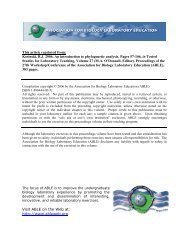Lumbriculus variegatus - Association for Biology Laboratory Education
Lumbriculus variegatus - Association for Biology Laboratory Education
Lumbriculus variegatus - Association for Biology Laboratory Education
You also want an ePaper? Increase the reach of your titles
YUMPU automatically turns print PDFs into web optimized ePapers that Google loves.
Appendix B: Preparation Notes<br />
Pulsation rate of blackworms 145<br />
Culturing Blackworms<br />
Fill a bucket, small aquarium, or large finger bowl with 2-3 inches of aged, dechlorinated water (or spring<br />
water). Add healthy worms (about 100) to the water and then layer the water with several small pieces of brown<br />
paper towel. Every week add one to two (depending on size of aquarium) pellets of sinking fish food. Do not<br />
overfeed! As water evaporates, add spring water to the original level. When the water begins to appear cloudy<br />
and/or starts to stink, slowly pour off as much of the water as possible without losing the paper towel pieces or the<br />
worms. Rinse the worms and paper towel once (with aged water) and then refill the aquarium (to 2-3 inches) with<br />
fresh water and a few new pieces of brown paper towel. If you are not using the worms <strong>for</strong> a while, split the<br />
culture or feed some of the extra worms to fish (the culture should double every 2-3 weeks and more quickly with<br />
slight agitation). This culture should live <strong>for</strong> a long time following these procedures.<br />
Handling Blackworms<br />
Worms are best handled by sucking them up with a plastic disposable pipet. Blow out the air in a pipet, place<br />
the pipet at a 45 degree angle, lower it to the bottom, and quickly suck up 1 or 2 worms at their head ends. If you<br />
dismember any of the worms in the process, just leave the pieces in the culture to regenerate.<br />
Using Cut Blackworms<br />
Blackworms that have been fragmented tend to move around less. Typically, the pulsation rate of a newly<br />
fragmented worm is close to the pulsation rate of a whole worm. At UD, we have the students actually verify this<br />
be<strong>for</strong>e “choosing” to use cut worms <strong>for</strong> their experiment. Each student group measures the pulsation rate of three<br />
cut and three whole worms (in approximately the same region of the worms), and then pool their data with the rest<br />
of the class. Then, as a class, we can decide if the pulsation rates are close or not. To save time, it may be best to<br />
either tell them that this is so or to have data available <strong>for</strong> whole worms and have the students see <strong>for</strong> themselves.<br />
If you do choose to use cut worms, these worms should be cut at least one day in advance so that the ends are<br />
healed. Select whole worms that are healthy and full-sized and cut them into thirds by placing them on a piece of<br />
saturated filter paper in a petri dish and cutting them with a clean, sharp razor blade. Keep the middle segments<br />
<strong>for</strong> the experiments and put the other two segments back into your culture so they can regenerate. Keep the<br />
middle segment worms separate from the whole worms and place both into separate bowls with fresh spring water<br />
<strong>for</strong> the lab exercise (label the bowls as “cut” and “whole”).<br />
Making “Widgets” (<strong>for</strong> moving worms)<br />
The following directions <strong>for</strong> making widgets is adapted from “A Toolbox <strong>for</strong> Working With Living<br />
Invertebrates,” by Dr. Charlie Drewes. This article can be found in ABLE’s 2004 proceedings.<br />
1. Materials: applicator stick (handle of a probe works well), rubber band, scissors, and tape.<br />
2. Cut, at an angle, a piece of rubber band that is one inch long.<br />
3. Attach the rubber band to one end of the applicator stick with tape, leaving _ inch of rubber band beyond the<br />
end of the stick.<br />
Making Viewing Slides<br />
The procedure <strong>for</strong> making tape well slides is also presented in the article listed above. You can also find<br />
directions, and pictures, <strong>for</strong> both widgets and slides at<br />
http://www.eeob.iastate.edu/faculty/DrewesC/htdocs/ (scroll down to “Gadgets & Technical In<strong>for</strong>mation”)<br />
Tape Well Slides:<br />
1. Materials: clear plastic tape (Scotch Colored Plastic Tape, Clear, 0.75” X 125”); <strong>for</strong>ceps; single edge<br />
razor blade; heavy scissors; heavy-duty, flexible clear plastic (or glass microscope slides); pen; ruler<br />
2. Using a pen and a ruler, mark off desired size slides on the plastic sheet.
















